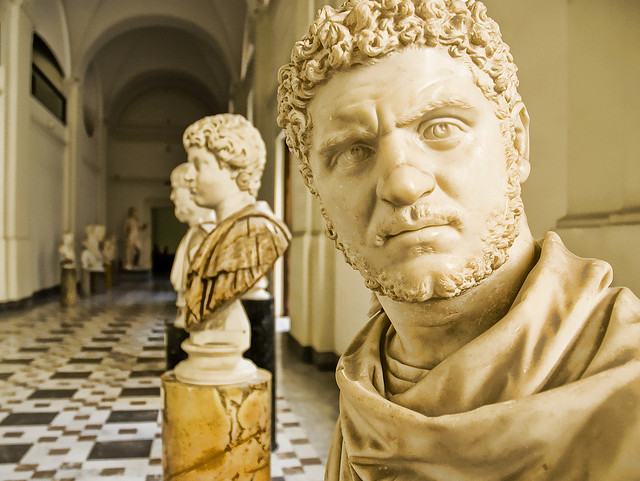Navigating Naples: The Italian Home of Great Art, Atmosphere, Architecture (and Pizzas)
NAVIGATING NAPLES: THE ITALIAN HOME OF GREAT ART, ATMOSPHERE, ARCHITECTURE (AND PIZZAS)Dr Joris van Gastel, History of Art
If Naples’ genius loci is to be found anywhere, it is in its own soil. The sea, of course, has played an important role in the city’s formation, but its significance is overshadowed by Vesuvius in the east, and in the West, the Campi Flegrei, literally, “burning fields”: an unearthly land of volcanic craters. The true Neapolitan pizza is directly anchored in the volcanic soil, as the protected San Marzano tomatoes, one of its key ingredients, are grown on the fertile slopes of the Vesuvius. Here too grow the grapes of the Lacryma Christi, an ancient wine inspired, according to legend, by the tears cried by Christ over Lucifer’s fall from Heaven. At the Campi Flegrei, the boiling pits of mud and sulphur fumes of the Solfatara were mined for sulphur and alum and inspired medical and geological debates. This is also the site of the beheading of Saint Januarius, the city’s patron saint. Three times a year, his blood, scraped from the executioners block and carefully preserved in the Saint’s chapel in the Duomo, liquefies miraculously. At the outbreak of the Vesuvius in 1631, it was Januarius who prevented the lava from destroying the city, “by virtue of his miraculous blood” as the text on the gate to his chapel reads. Not just the food and cults, but the very fabric of the city is grounded in its geological environment. The city is largely built from the porous yellow tuff stone, a volcanic stone that is found directly under the city and that is so soft that it can be cut with a saw. As the tuff is often hidden behind layers of stucco, another volcanic stone, the dark grey piperno, is more visible, being used to give dark accents to the baroque palaces and churches. As early as the second half of the eighteenth century, a royal decree was issued, prohibiting the use of stone from under the city itself, in the hope to avoid the danger of houses being devoured by the ground. It has been with little effect. Centuries of mining have left the hills of Naples porous as the stone itself, a porosity that, as Walter Benjamin has pointed out, continues in the houses and lives of Naples. The fluent boundaries between inside and outside, between above and below ground, make it easy to understand why the cult of purgatory has been so persistent here. Indeed, in his Aeneid, Virgil found the gate to the underworld among the craters of the Campi Flegrei. In contemplating these fluid boundaries, though seemingly more the field of anthropologists, the art historian too might begin to understand something of the art of Naples. The Neapolitan “love of splendour”, as Jacob Burckhardt called it, has often been perceived as something superficial, something not worthy of further exploration. And yet, we may find that this profound interest in costly, sometimes exotic materials has it grounds in the city’s geological context as well. Whereas Saint Januarius’ blood protects the city in the miracle of its liquefaction, these costly materials might be said to provide a solid ground of a more profane kind. For now, it remains an interesting idea, an idea I hope to further explore in the future. It could make us aware, however, of something that modern man has lost: a connection with the very materials that constitute the world we live in. A descent into the city of Naples, can give us too, a solid ground among its chaos. Interested in art? Find out more about studying the History of Art at Warwick.
Image: A Quizzical Look by Trey Ratcliff (via Flickr) |


 Dr Joris van Gastel studied Psychology and Art History at the VU University Amsterdam and the Università Ca’ Foscari, Venice. Between 2006 and 2011 he was part of the interdisciplinary research project Art, Agency and Living Presence in Early Modern Italy based at Leiden University, in the context of which he wrote his PhD thesis Il Marmo Spirante: Sculpture and Experience in Seventeenth-Century Rome. He has held fellowships at the Royal Dutch Institute in Rome, the Stiftung Preußischer Kulturbesitz, Berlin, the Fondazione Ermitage Italia, Ferrara, and the Kolleg-Forschergruppe Bilddakt und Verkörperung, also in Berlin.
Dr Joris van Gastel studied Psychology and Art History at the VU University Amsterdam and the Università Ca’ Foscari, Venice. Between 2006 and 2011 he was part of the interdisciplinary research project Art, Agency and Living Presence in Early Modern Italy based at Leiden University, in the context of which he wrote his PhD thesis Il Marmo Spirante: Sculpture and Experience in Seventeenth-Century Rome. He has held fellowships at the Royal Dutch Institute in Rome, the Stiftung Preußischer Kulturbesitz, Berlin, the Fondazione Ermitage Italia, Ferrara, and the Kolleg-Forschergruppe Bilddakt und Verkörperung, also in Berlin.